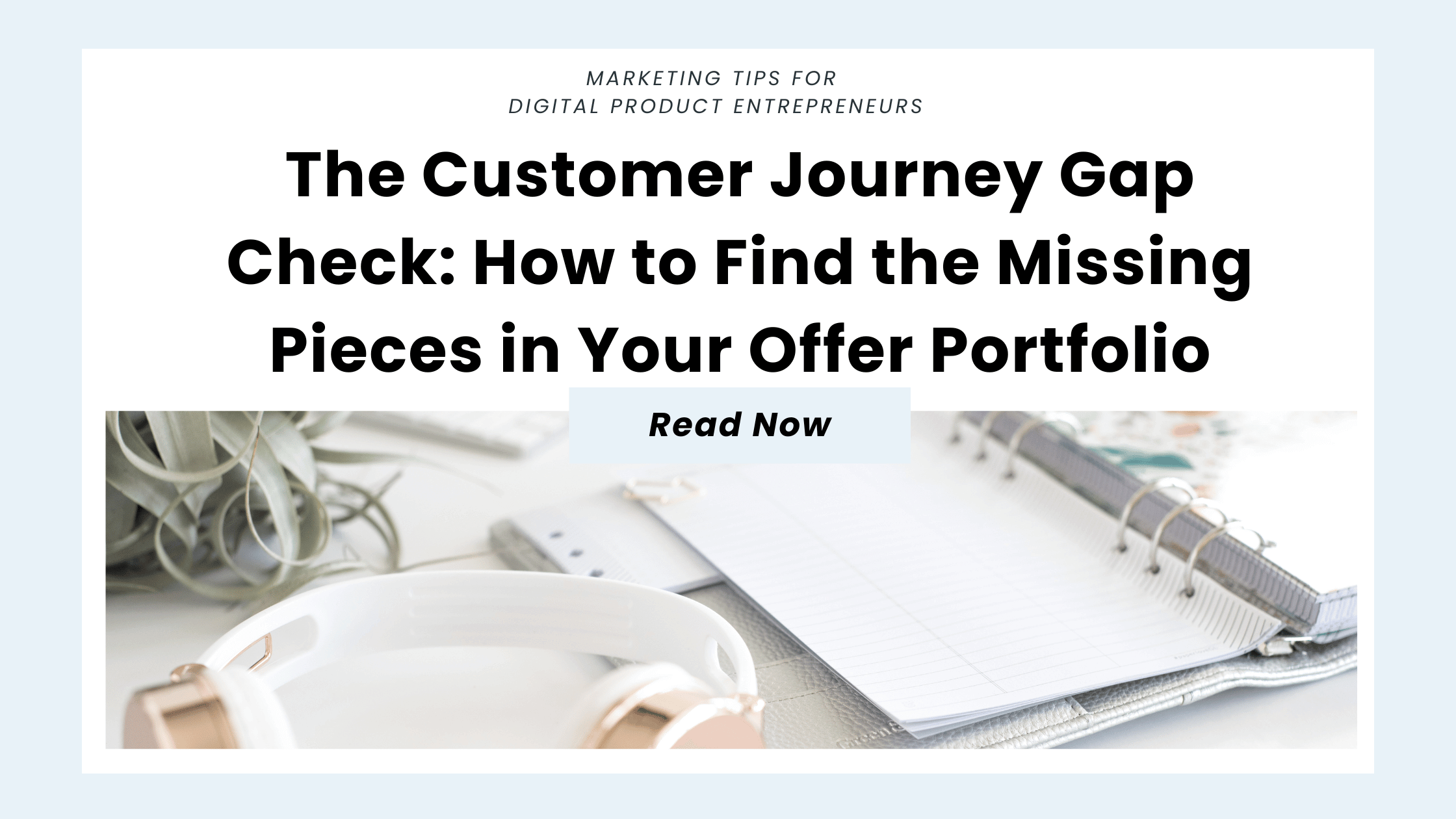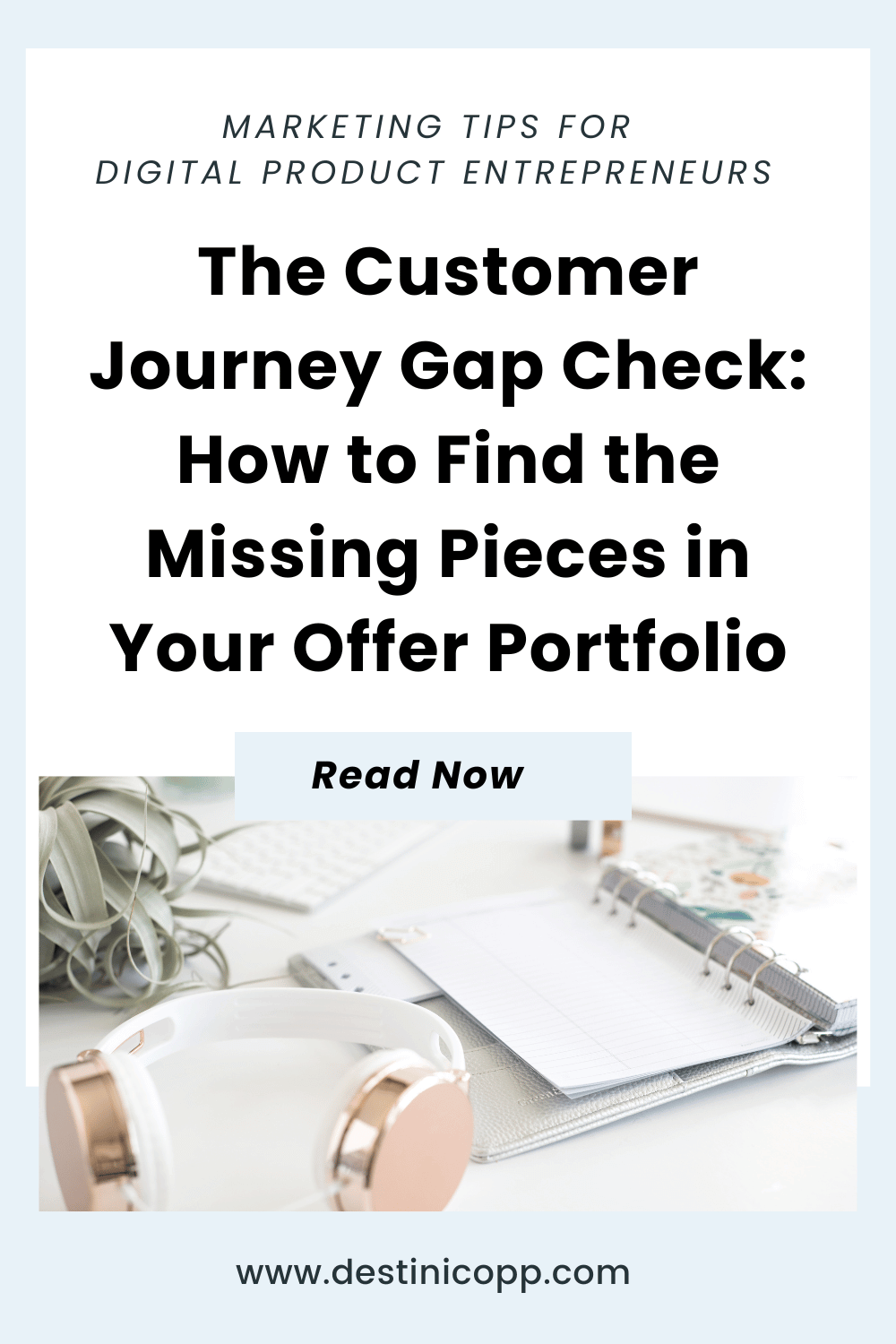The Customer Journey Gap Check: How to Find the Missing Pieces in Your Offer Portfolio
Most creators I talk to have no shortage of offers. Courses, memberships, templates, digital downloads, coaching packages — the list goes on.
But here’s the truth: having “more” doesn’t always mean you have momentum.
What actually creates momentum is alignment. Every offer should have a place in your business model, and every offer should move your customer forward along their journey with you.
That’s where the Customer Journey Gap Check comes in.
In this article, I’ll walk you through how to audit your current portfolio against the customer journey, identify missing pieces, and create clarity around what to sell, when, and to whom.
By the end, you’ll have a simple tool you can use to:
Eliminate overwhelm in your product suite
Set smarter revenue goals
Spot gaps in your customer’s journey (and opportunities for growth)
Align your next 90 days of marketing to the right offers
Let’s dive in.
Why the Customer Journey Matters More Than the Offer List
Most entrepreneurs build their business like a garage sale.
They create things when inspiration strikes:
A mini-course here.
A PDF template there.
A coaching package when someone asks for 1:1 help.
Before long, they’ve got a pile of offers. But not a clear path.
The customer journey changes that. Instead of looking at your portfolio as a random stack, you look at it as a map.
Every business, no matter the niche, moves customers through a similar flow:
Awareness → They discover you exist.
Subscribe → They raise their hand to hear from you (usually via email).
First Purchase → They make a small, low-risk buying decision.
Repeat Buyer → They buy again, often at a higher level of commitment.
Loyalty/Advocacy → They become long-term customers, promoters, and superfans.
Your goal isn’t to have an offer at every single stage from day one — but the more aligned your offers are to this journey, the more predictable (and scalable) your revenue becomes.
Step 1: Map Out Your Current Offers
Start by listing everything you sell (or have sold in the past):
Freebies and lead magnets
Digital products
Courses and memberships
Services and coaching packages
Events or workshops
Don’t judge yet. Just get it all down on paper.
👉 Pro Tip: Use a spreadsheet for this. It’s much easier to sort, color-code, and visually group your offers when you see them in one place.
Step 2: Place Each Offer on the Customer Journey
Now comes the fun part: assign each offer to the stage of the customer journey it best supports.
Awareness: Do you have a discovery mechanism? Blog, podcast, YouTube, social media, partnerships, or ads?
Subscribe: What’s your primary lead magnet or freebie? Do you have more than one?
First Purchase: Do you have a clear, low-cost entry offer (a $7–$49 range digital product, tripwire, or workshop)?
Repeat Buyer: What’s the next logical step for someone who already purchased? Do you have a mid-tier product, membership, or higher-ticket offer?
Loyalty/Advocacy: Do you have a way to deepen the relationship—annual memberships, advanced programs, or ambassador opportunities?
If you find yourself staring at an empty column (say, nothing in “First Purchase”), congratulations: you’ve just spotted a growth gap.
Step 3: Identify the Gaps (and the Overlaps)
This is where clarity happens. You’ll usually see one of two problems:
1. Gaps:
You’re missing an offer at a critical stage. For example, you have tons of free content and a high-ticket program, but no low-cost entry point. That’s a recipe for low conversions.
2. Overlaps:
You have multiple offers competing for the same stage. For example, three different $27 products that all claim to be the “perfect first step.” This creates confusion (for you and your customer).
Either way, the gap check gives you direction. You’ll know whether your next 90 days should be focused on filling in a gap, streamlining overlaps, or optimizing the journey you already have.
Step 4: Clarify Core vs. Optional Offers
Not every offer deserves equal attention.
Think of your portfolio like a tree:
The core offers are the trunk. They carry the weight of your business.
The optional offers are the branches. They’re nice to have, but not required.
Ask yourself: If I had to rebuild my business from scratch tomorrow, which 1–2 offers would I launch first?
Those are your core. Everything else is optional.
Once you’ve identified your core, make sure every gap you fill (or every new idea you create) directly supports those core offers.
Step 5: Align Your Marketing & Sales Strategy
Here’s where the Customer Journey Gap Check turns into a growth plan.
If your gap is in Awareness: Invest in collaborations, content, or ads to get in front of more people.
If your gap is in Subscribe: Optimize your lead magnet, landing page, or list-building strategies.
If your gap is in First Purchase: Create or highlight a low-cost product that makes saying “yes” easy.
If your gap is in Repeat Buyer: Build pathways from your entry products into your membership, signature program, or coaching.
If your gap is in Loyalty/Advocacy: Add annual plans, referral programs, or exclusive perks.
The beauty of this exercise? You can now tie your goals to actual offers, not random revenue targets.
A Real-World Example
Let’s say your portfolio looks like this:
Free lead magnet: “5-Day Challenge” (Subscribe)
Mini-course: $27 (First Purchase)
Membership: $49/month (Repeat Buyer)
VIP Coaching: $500/month (Repeat Buyer → Loyalty)
But when you map it out, you notice:
You have almost no Awareness mechanism — no collaborations, no evergreen content strategy.
You don’t have a true Loyalty/Advocacy layer — there’s no annual plan, alumni community, or referral program.
Your growth plan becomes obvious:
Spend the next quarter focused on list growth (fix the Awareness gap).
Create an annual plan or referral incentive for your membership (fill the Loyalty gap).
That’s the power of the gap check: clarity + focus.
Common Mistakes to Avoid
Adding offers too quickly. Filling a gap doesn’t always mean building something new. Sometimes it’s about repackaging what you already have.
Ignoring overlaps. Too many offers in the same stage can be just as damaging as having none. Simplify before you add.
Chasing “shiny object” products. Every new idea should serve a purpose in the journey. If it doesn’t, park it for later.
Forgetting the customer perspective. You might see a clear path, but if your customers can’t connect the dots, it won’t work.
How Often Should You Do a Gap Check?
At least once per quarter.
Why? Because businesses evolve. You’ll launch new offers, retire old ones, and experiment with strategies.
A quarterly audit ensures your portfolio stays aligned with your goals and your customer’s needs.
Bringing It All Together
The Customer Journey Gap Check is simple, but it’s powerful.
Map your current offers.
Place them along the customer journey.
Identify the gaps and overlaps.
Clarify your core vs. optional offers.
Align your next 90 days of marketing to what matters most.
When you do this consistently, you’ll always know where to focus—and your revenue will grow predictably instead of sporadically.
Want Help Doing This Live?
Inside the Creator’s MBA Lab, we’re running a live workshop on October 8 where I’ll guide members through this exact process.
We’ll use the Offer Audit Spreadsheet, map everything to the customer journey, and create a one-page portfolio map + 90-day scorecard you can use immediately.
✨ If you’ve ever felt like your offers were scattered, this is the workshop that will bring it all together.
👉 Join the Creator’s MBA Lab today to reserve your spot.




